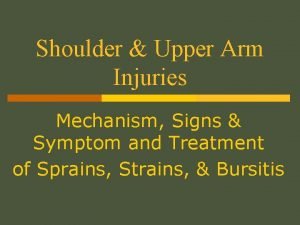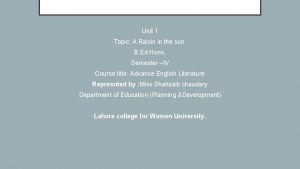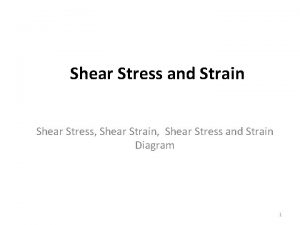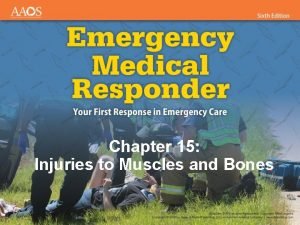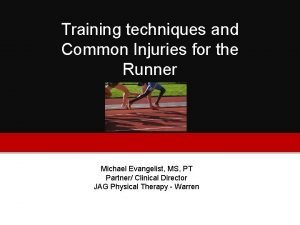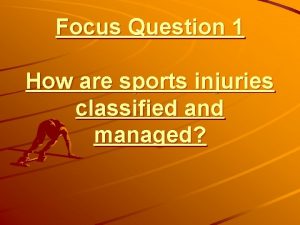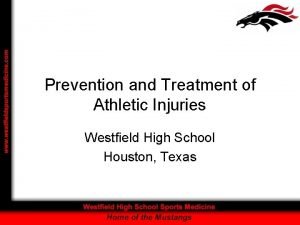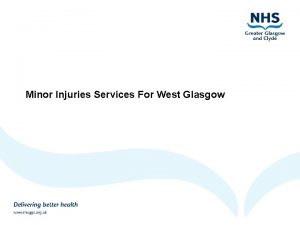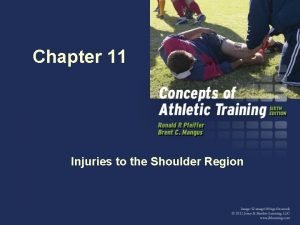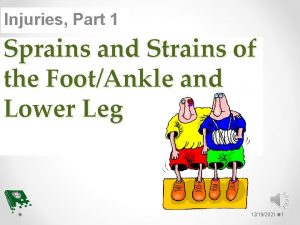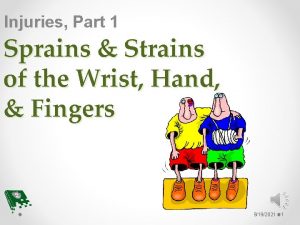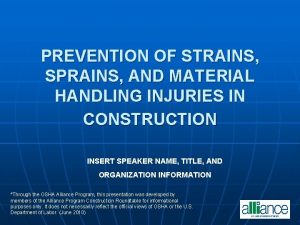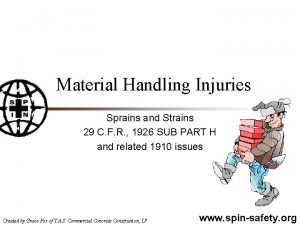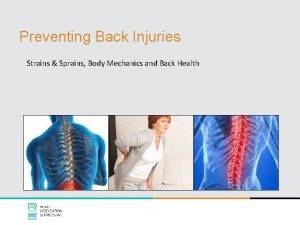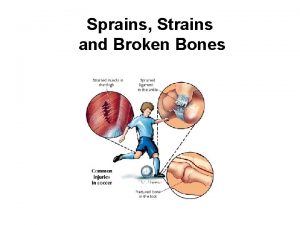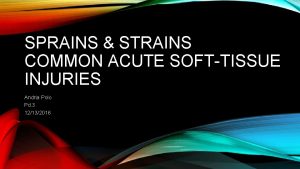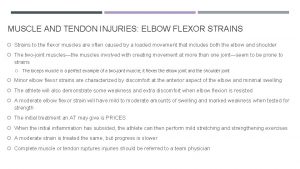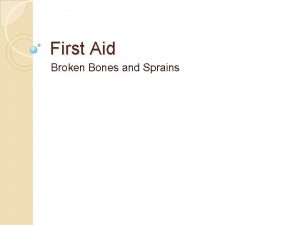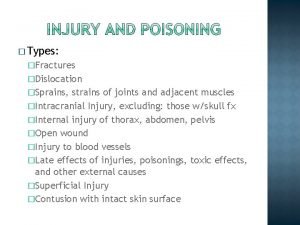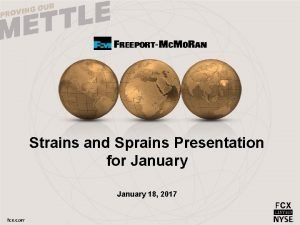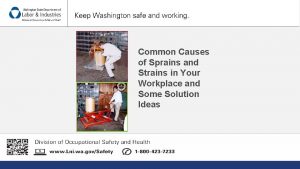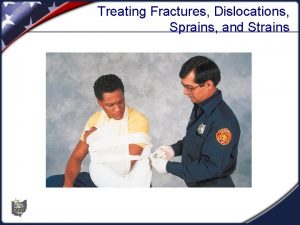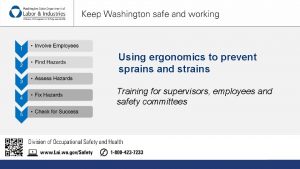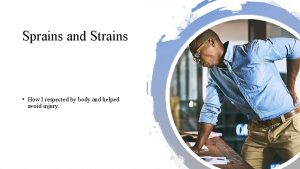Injuries Part 1 Sprains and Strains of the





















- Slides: 21

Injuries, Part 1 Sprains and Strains of the neck and spine

“Before & After” BELLWORK Using a piece of notebook paper, answer the following questions, leaving a line between each answer. Put the paper aside until the end of class. 1. How do you get a neck muscle strain? 2. How do you get a neck sprain? 3. What does a neck muscle strain look like? 4. What does a neck sprain look like?

Objective 1. Differentiate between common injuries and their mechanisms, signs, symptoms and treatments.

3 PART INTERVIEW �Find a partner. One person assumes the role of the interviewer and one is the interviewee. �The interviewer asks the assigned questions and notes the answers on paper. �Switch roles and repeat the process. �When time is called, be prepared to share the results of your interview with the class.

Questions on the neck and spine 1. Have you ever been injured or was someone you know injured? What was the injury? 2. What was the etiology/mechanism? 3. What was the pathology? 4. What was the treatment?

Terminology • • • Cervical collar- soft brace that fits around an athletes’ neck Intermittently- alternating stopping and beginning again Radiating- to spread out in a direction from the center

Cervical Sprain Mechanism Despite having an excellent Range of Motion, it is subject to ligament sprains when it is forcefully moved beyond its normal range. Mechanism: turning head to catch a ball and then athlete gets tackled by a defender. When hit forcefully from behind, the receiver often suffers a whiplash injury. The body is forced forward by the blow while the head moves backward which places the cervical spine into extension and stretches the ligaments and muscles at the front of the neck.

Cervical Sprain Signs and Symptoms �Usually intense pain if sprain is located in the neck �Palpation of the injured area is usually painful if the joint is sprained

Treatment of a Neck Strain �Rest �Ice (twenty minutes intermittently 6 -8 times a day) �Cervical collar if warranted �Perform spinal tests to rule out possible paralysis �Refer to doctor if needed

Neck Flexors Scaleni Sternocleidomastoid

Cervical Nerve Stretch Syndrome “Burner” Mechanism Head is forced into a lateral position while athlete’s arm is pulled in the opposite direction

Cervical Nerve Stretch Syndrome “Burner” Signs and Symptoms Typically athlete walks off the field with his neck pulled toward the side and the athlete is supporting his arm • This mechanism of injury can result in burning, tingling, numbness, and stinging sensations • Athlete may recover in seconds or minutes •

Treatment for Cervical Nerve Stretch Syndrome “Burner” � Watch athlete carefully � Athlete monitors the intensity of the burning � Between 2 -5 minutes the intensity should lower dramatically or disappear � Manual muscle test for strength and parethesia � Athlete stretches neck muscles, shoulder muscles and prepares to re-enter game/practice. � Instruct athlete to see athletic trainer after

Low Back Muscle Strains Mechanism Sudden rotation and contraction on an overloaded, unprepared or underdeveloped spine.

Low Back Muscle Strains Signs and Symptoms • • • Discomfort in low back may be diffused or localized in one area Pain will be present on active extension and with passive flexion No radiating pain

Low Back Muscle Strain Treatment �Ice 20 minutes 4 -6 times a day �Gradual stretching and progressive strengthening once pain has subsided

Lumbar Sprain Mechanism Typically occurs when the athlete bends forward and twists while lifting or moving some object. A traumatic force over extends the spinal joints and causes a sudden onset of deep sharp pain.

Lumbar Sprain Signs and Symptoms �Pain is localized �Located just lateral of the spinous process �Pain becomes sharper with certain movements �Any anteroposterior or rotational movement increases pain

Lumbar Sprain Treatment � R. I. C. E � Athlete may have to wear a supported brace � Stretching in all directions, (ROM) should be limited to a pain free range � Once appropriate, strengthening exercises for abdominals and back extensors should be initiated � Doctor referral may be indicated

“What’s My Injury? ” �With a partner, choose an injury from today’s lesson �Write a creative scenario about that injury including the etiology, pathology, and treatment for the injury �Be prepared to share with the class

“Before & After” BELLWORK Answer the following questions on the blank lines below your Bellwork answers to assess new learning. 1. How do you get a neck muscle strain? 2. How do you get a neck sprain? 3. What does a neck muscle strain look like? 4. What does a neck sprain look like?
 Sprains and strains
Sprains and strains What are the greatest strains on walter and ruth's marriage
What are the greatest strains on walter and ruth's marriage Stress strain
Stress strain Unit 15:10 providing first aid for specific injuries
Unit 15:10 providing first aid for specific injuries Chapter 28 head and spine injuries
Chapter 28 head and spine injuries Chapter 21 caring for head and spine injuries
Chapter 21 caring for head and spine injuries Chapter 15 injuries to muscles and bones
Chapter 15 injuries to muscles and bones Chapter 14:2 preventing accidents and injuries
Chapter 14:2 preventing accidents and injuries Chapter 14 bleeding shock and soft tissue injuries
Chapter 14 bleeding shock and soft tissue injuries Chapter 13:2 preventing accidents and injuries
Chapter 13:2 preventing accidents and injuries Chapter 11 assessment and evaluation of sports injuries
Chapter 11 assessment and evaluation of sports injuries Glencoe health chapter 12
Glencoe health chapter 12 Common track injuries
Common track injuries How are sports injuries classified and managed
How are sports injuries classified and managed Beck weathers injuries
Beck weathers injuries Hunger games questions by chapter
Hunger games questions by chapter Sentinel injuries
Sentinel injuries Westfield sports injuries
Westfield sports injuries Stobhill miu
Stobhill miu First aid aims
First aid aims 17:3 providing first aid for bleeding and wounds
17:3 providing first aid for bleeding and wounds Chapter 11 injuries to the shoulder region
Chapter 11 injuries to the shoulder region
